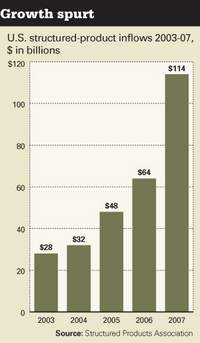A New Way To Play The Job Market -- But Will The CME's New Futures Product, Based On Nonfarm Payrolls Data, Allow Investors To Hedge Against Stock, Bond, Or Currency Market Jitters?
You may already feel your own job prospects are a toss of the dice. Soon, though, you'll be able to bet on the state of the whole U.S. job market.
Starting in April, average investors can express their views about where the economy stands through a new futures product based on one of the most closely watched economic indicators: the nonfarm payrolls data contained in the Labor Dept.'s monthly employment report. It is the first of several financial derivatives based on economic indicators the Chicago Mercantile Exchange plans to launch.
The exchange says the payroll futures will let investors hedge against stock, bond, or currency market jitters amid worries about an economic downturn.
Many traders and analysts, however, are skeptical the new product will be very popular beyond pure speculators.The nonfarm payrolls number instantly joins such unsexy futures products as butter, soybeans, and random length lumber. Released by the Bureau of Labor Statistics [BLS] the first Friday of every month, the payroll number measures the total number of U.S. workers, except those in government, farms, some nonprofits, and working for themselves at home. As such, it is seen by economists as a timely, reliable indicator of the health of the broad U.S. economy. When released by the BLS, the monthly payrolls figure often moves the stock market, especially if it offers up a surprise.
Future ChallengesFutures traders, of course, already bet on all sorts of predictable events: inches of snowfall, frost days, hurricanes. The concept of trading economic indicators is not new, either. Back in 2002, options based on the BLS jobs data were first traded in auctions hosted by Deutsche Bank (DB) and Goldman Sachs (GS). Today, a few economic and housing derivatives are traded on over-the-counter markets among banks and funds. But the price of those products can be skewed by things such as a participant's credit position and the limited number of possible buyers.
"What happens [with the OTC market] is that it's bilateral, and when credit dries up and you have less counterparties, the market becomes illiquid and less efficient," says Felix Carabello, director of alternative investment products at CME Group (CME), which is the newly merged Chicago Mercantile Exchange and Chicago Board of Trade.
Some argue the opaque and concentrated nature of the over-the-counter market for many derivatives products is partly responsible for the plunging values of many housing-related securities held by banks.
But there are other challenges for an economics-oriented futures product. Most obviously, there is no tangible underlying asset for the contract, like there is for gold or corn. A company that uses the futures contract's underlying product -- say, oil -- could take delivery of the commodity, though it rarely happens. No one produces or consumes the nonfarm payroll number. Hence, there is no steady demand from businesses who must buy the futures in order to keep their operations running risk-free.
(To read the complete article from BusinessWeek.com, click here.)
Sunday, April 20, 2008
Subscribe to:
Post Comments (Atom)




No comments:
Post a Comment